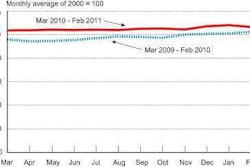Federal energy research and development programs that will play a significant role in helping the United States achieve a 20 percent increase in freight fuel economy should not have their funding dramatically reduced this year, the Diesel Technology Forum stated Thursday, April 14, in testimony submitted for a congressional hearing by the U.S. Senate Subcommittee on Energy and Water Development.
In the testimony, DTF Executive Director Allen Schaeffer stated the reduction in funding for the Advanced Combustion Engine Research and Development Program and the Vehicle Technologies Program in the proposed fiscal year 2012 budget would decrease advances in freight fuel efficiency significantly. These programs are funded under the U.S. Department of Energy’s Energy Efficiency and Renewable Energy budget.
“There is an incontrovertible and established need to improve energy efficiency of the nation’s commercial vehicles,” Schaeffer stated. “Commercial diesel-powered trucks are the backbone of the U.S. economy and the prime movers of the nation’s goods movement system, and will be for the foreseeable future. Fuel consumption in this sector is projected to continue to grow with the economy.”
Schaeffer said past EERE engine and vehicle efficiency programs have delivered substantial and well-documented economic, energy and environmental benefits to society. “However, the continued progress of these efforts is in jeopardy due to an imbalanced fiscal year 2012 budget request,” he said.
Schaeffer said the fiscal year 2012 EERE budget proposes to reduce ACE R&D by 12.4 percent from fiscal year 2010 appropriated levels ($55.987 million to $49 million); a reduction of $5 million for fuels technologies; and reduction of $2 million to 3 million in materials technologies.
“A national energy strategy should seek to balance investments in near-term and long-term energy-saving strategies,” Schaeffer said. “Proven incremental gains in efficiency from existing fuels and technologies, particularly in sectors that use the most energy today without viable alternatives for the future, must be a cornerstone of the national energy program and funded accordingly. While battery development and electric-powered vehicles may hold great promise, so too should investments in programs with assured near-term efficiency gains.”
Schaeffer described the diesel engine is the prime mover of America’s transportation, infrastructure and goods movement today and for the foreseeable future. “Now with near-zero emissions and still as the most energy-efficient internal combustion engine – 30 percent more efficient than gasoline – clean diesel technology has made great progress and has substantial future potential efficiency gains to meet future societal goals.”
Schaeffer said the established goal of improving fuel economy by 20 percent for commercial vehicles in the ACE R&D has the potential to save more energy than the electrification of one million cars. “Past investments have contributed to diesel engine manufacturers being able to meet the most stringent emissions standards on record, resulting in today’s clean diesel technology with near-zero emissions of ozone-forming compounds and particulate matter,” he said. “The total health and environmental benefits in terms of savings in air pollution and energy savings exceed $70 billion dollars.”
Schaeffer said adequate DOE program funding can assure that the commercial vehicle, engine and SuperTruck program goals of 50 percent increase in ton-miles-per-gallon freight efficiency will be more likely to be met. “Truck and engine manufacturers face the unique challenge of competing societal demands of improved efficiency and near-zero emissions while meeting customer demands for lowest cost of operation,” he said.
Schaeffer said significant investments in research are required, but there are diminishing opportunities to recoup the substantial investments needed to meet those goals with only an average 200,000 to 250,000 heavy-duty trucks sold annually. “A fully funded SuperTruck program can assure these goals are more likely to be accomplished earlier than if companies alone shoulder larger research demands,” he said.










